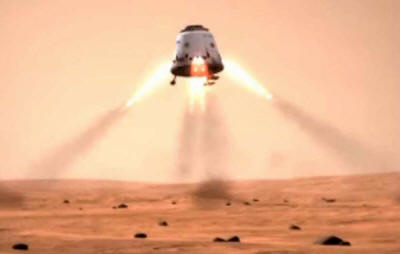|
November 27, 2012
Artist Drawing of
SpaceX Mars Colony
In 1606, King James I of England granted the first Royal Charter to establish colonies in the New World.
In a modern day reprise, Elon Musk, the founder of ...plans to build a colony of up to 80,000 people on Mars.
Taking a trip to Mars, if Musk has his way, would cost as little as $500,000. Musk revealed his long term plans in a November 16 presentation at the Royal Aeronautical Society.
In an interview, Musk revealed that establishing a Martian colony was his ultimate objective, and “it always has been.”
Given his recent space accomplishments, successfully sending an unmanned space vehicle to the International Space Station and back - Musk’s Mars vision is no idle pipedream.
While it may take several decades to achieve his vision using conventional rocket propulsion technologies, this could be a new first for Musk. Or would it?
According to whistleblowers, elements of the US military possess a secret space fleet that uses antigravity technologies, and is already capable of interplanetary flight to Mars and beyond. A secret attempt to declassify antigravity technology by the Boeing Corporation during the Clinton administration failed.
Apparently, the world’s leading aeronautical company was prevented from introducing the next generation of propulsion technologies for the aviation industry for national security reasons.
There is also reason to believe that there was an unsuccessful attempt by the Obama administration, under his former national security advisor General Jim Jones, to have antigravity technologies declassified.
One day in the not too distant future, currently classified antigravity technologies that will revolutionize the aviation and space industry will be released. Musk’s vision of a Mars colony would then come into fruition much more quickly than he can currently envision.
Elon Musk’s immediate plan is for SpaceX to send manned flights to the International Space Station in the next few years.
With two successful missions to the ISS and back using his Dragon Spacecraft, there is little doubt that Musk will achieve his goal unless something unexpected happens. Musk will eventually turn his attention to Mars, and contemplate how to achieve his vision using existing propulsion technologies based on liquid fuel propellants.
In his talk at the Royal Aeronautical Society, Musk said:
The main challenge is that present propulsion technologies make manned missions to Mars prohibitively expensive.
NASA has dropped plans for a manned mission to Mar due to the 100 billion budget. With a yearly budget of only $19 billion, NASA would have to be part of an international consortium, and even then the overall cost might be too much.
So can private space entrepreneurs such as Musk, succeed where governments cannot?
Perhaps, but Musk would do so far more quickly if classified aerospace technologies based on antigravity principles were released.
It was revealed in 1992, for example, that the B-2 Bomber used electrostatic charges on its leading wings and exhaust. According to aerospace experts, this was confirmation that the B-2 used electrogravitic principles based on the Biefeld-Brown Effect.
The Biefeld-Brown Effect is based on the research of Thomas Townsend Brown who in 1928 gained a patent for his practical application of how high voltage electrostatic charges can reduce the weight of objects. The B-2 bomber employs sufficiently high voltages to significantly reduce its weight.
This enables the B-2 and other classified antigravity vehicles to display flight characteristics that appear to defy conventional laws of physics.
During the early period of the Obama administration there may have been an attempt to have such technology declassified. The key Obama appointee for the attempt to introduce antigravity technology into the public sector was very likely General James Jones who was President Obama’s first national security advisor.
After retiring from the Marines on February 1, 2007, General Jones served on the Board of Directors of the Boeing Corporation from June 21, 2007 to December 15, 2008. Boeing had been active at least since the early 1990’s in studies to apply antigravity technology for commercial use.
In 2002, an internal Boeing project called “Gravity Research for Advanced Space Propulsion” (GRASP) had been disclosed to the aerospace industry.
A GRASP briefing document obtained by Jane’s Defense Weekly stated Boeing’s position:
According to a 2008 book (Secrets of Antigravity Technology) by Dr Paul LaViolette, Boeing completed a separate classified study for the U.S. military of electrogravitic propulsion recently before October 2007.
Boeing was rebuffed in its efforts to have such technology declassified and released into the public sector. As a Board Director and member of Boeing’s Finance Committee at the time of the 2007 classified study, General Jones was privy to and supported Boeing’s efforts in antigravity research and development.
At the same time that Boeing was actively seeking to develop antigravity technologies for a new generation of aircraft, Jones became President of the Institute for 21st Century Energy.
The Institute was created by the U.S. Chamber of Commerce with the following mission:
As Obama’s first National Security Advisor, General Jones was well placed to ensure that “new energy ideas” would be integrated into a comprehensive national security policy by the Obama administration.
Unfortunately, Jones was stymied in his efforts to move forward with his new energy agenda, and was replaced in October 2010 less than two years after taking the job. As happened earlier during the Clinton administration with the Boeing Corporation, efforts to declassify antigravity technology for the civilian aviation sector had been stymied by powerful opponents.
There is little reason to doubt that space entrepreneurs such as Elon Musk could succeed in ambitious plans to achieve manned space flight to Mars, and eventually establish a human colony of up to 80,000 or more.
Musk could become a modern day equivalent of William Penn and others granted Royal Charters by the English Crown that established colonies in the New World during the 17th century.
The cost and time for achieving Musk’s Mars vision will take several decades using conventional rocket propulsion technologies.
If antigravity technologies were declassified and released for commercial application, then Musk’s Martian colony could be brought into fruition much sooner - even before the end of this decade.
A $500,000 ticket to Mars may not be that far off into the future after all!
...Eyed by SpaceX Founder
from
DiscoveryNews Website
Elon Musk want to foster a Mars colony of up to 80,000 people by ferrying explorers
to the Red Planet for $500,000 a trip.
Elon Musk, the billionaire founder and CEO of the private spaceflight company SpaceX, wants to help establish a Mars colony of up to 80,000 people by ferrying explorers to the Red Planet for perhaps $500,000 a trip.
In Musk's vision, the ambitious Mars settlement program would start with a pioneering group of fewer than 10 people, who would journey to the Red Planet aboard a huge reusable rocket powered by liquid oxygen and methane.
Musk was there to talk about his business plans, and to receive the Society's gold medal for his contribution to the commercialization of space.
Elon Musk wants to help establish a Mars colony of up to 80,000 people by ferrying explorers to the Red Planet.
Mars pioneers
Accompanying the founders of the new Mars colony would be large amounts of equipment, including machines to produce fertilizer, methane and oxygen from Mars’ atmospheric nitrogen and carbon dioxide and the planet's subsurface water ice.
The Red Planet pioneers would also take construction materials to build transparent domes, which when pressurized with Mars' atmospheric CO2 could grow Earth crops in Martian soil.
As the Mars colony became more self sufficient, the big rocket would start to transport more people and fewer supplies and equipment.
Musk's architecture for this human Mars exploration effort does not employ cyclers, reusable spacecraft that would travel back and forth constantly between the Red Planet and Earth - at least not at first
Musk also ruled out SpaceX's Dragon capsule, which the company is developing to ferry astronauts to and from low-Earth orbit, as the spacecraft that would land colonists on the Red Planet.
When asked by SPACE.com what vehicle would be used, he said,
Asked if the "entire thing" is the huge new reusable rocket - which is rumored to bear the acronymic name MCT, short for Mass Cargo Transport or Mars Colony Transport - Musk said,
Musk has been thinking about what his colonist-carrying spacecraft would need, whatever it ends up being. He reckons the oxygen concentration inside should be 30 to 40 percent, and he envisions using the spacecraft's liquid water store as a barrier between the Mars pioneers and the sun.
A $500,000 ticket
Musk's $500,000 ticket price for a Mars trip was derived from what he thinks is affordable.
He also estimated that of the eight billion humans that will be living on Earth by the time the colony is possible, perhaps one in 100,000 would be prepared to go. That equates to potentially 80,000 migrants.
Musk figures the colony program - which he wants to be a collaboration between government and private enterprise - would end up costing about $36 billion.
He arrived at that number by estimating that a colony that costs 0.25 percent or 0.5 percent of a nation's gross domestic product (GDP) would be considered acceptable.
The United States' GDP in 2010 was $14.5 trillion; 0.25 percent of $14.5 trillion is $36 billion.
If all 80,000 colonists paid $500,000 per seat for their Mars trip, $40 billion would be raised.
The big reusable rocket
The fully reusable rocket that Musk wants to take colonists to Mars is an evolution of SpaceX's Falcon 9 booster, which launches Dragon.
SpaceX is already testing what Musk calls a next-generation, reusable Falcon 9 rocket that can take off vertically and land vertically.
The prototype, called Grasshopper, is a Falcon 9 first stage with landing legs.
Grasshoper has made two short flights. The first was on Sept. 21 and reached a height of 6 feet (2 meters); the second test, on Nov. 1, was to a height of 17.7 feet (5.4 m).
A planned milestone for the Grasshopper project is to reach an altitude of 100 feet (30 m). [Grasshopper Rocket's 2-Story Test Flight (Video)]
Musk wants to have a reusable Falcon 9 first stage, which uses Grasshopper technology, come back from orbit in "the next year or two." He then wants to use this vertical-landing technology for Falcon 9's upper stage.
Musk hopes to have a fully reusable version of Falcon 9 in five or six years, but he acknowledged that those could be "famous last words."
A rocket stepping stone
Another stepping stone toward the planned reusable Mars rocket is SpaceX's Falcon Heavy launcher.
With a first flight planned for next year from Vandenberg Air Force Base in California, the Heavy is a Falcon 9 that has two Falcon 9 first stages bolted on either side.
Musk expects the Falcon Heavy to launch from Florida's Cape Canaveral eventually. This triple-first-stage rocket will be able to put 116,600 pounds (53,000 kilograms) into a 124-mile (200 kilometers) low-Earth orbit. But the Falcon Heavy is still much smaller than Musk’s fully reusable Mars rocket, which will also employ a new engine.
While Musk declines to state what the Mars rocket's payload capability will be, he does say it will use a new staged combustion cycle engine called Raptor.
The cycle involves two steps. Propellant - the fuel and oxidizer - is ignited in pre-burners to produce hot high-pressure gases that help pump propellant into the engine's combustion chamber. The hot gases are then directed into the same chamber to aid in the combustion of the propellants.
Because Raptor is a staged combustion engine - like the main engines of NASA's now-retired space shuttle fleet - it is expected to be far more efficient than the open-cycle Merlin engines used by the Falcon 9.
While the Falcon 9's engines use liquid oxygen (LOX) and kerosene, Raptor will use LOX and methane.
Musk explained that,
|



